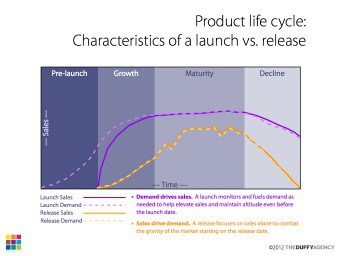Why do most marketing initiatives fail?
“Our tools are better. Our information is better. So why aren’t we better?”...
17 Sep 2024 2557 Views
“Our tools are better. Our information is better. So why aren’t we better?”
Have you ever seen a headline in the business press claiming that most brand launches or M&A-related rebrands fail? I have. In fact, I’ve been reading versions of the same dismal headline since I began my career in Marketing three decades ago. Despite mind-bending advances in communication, technology, and data, the discipline of Marketing seems immune to progress. Our tools are better. Our information is better. So why aren’t we better? I want to get to the heart of this question but to do that I’ll start a little lower in the anatomy.
What are the main reasons of marketing failure?
Risky Business
Two hundred and eighty-five years ago today, on October 8th, 1735, 11-year old Hanvil Anderson underwent the first appendectomy at St. George’s Hospital in London. His surgeon Claudius Aymand described the procedure as “the most complicated and perplexing I ever met with.”1 Sadly, young Hanvil did not survive the procedure.
At that point in time, the mortality rate for surgical intervention of appendicitis was 100%, and so it remained for the next hundred and thirteen years. However, after each failed procedure, detailed autopsies were conducted to understand and improve. In 1848 the first successful surgery was performed by Henry Hancock at the Charing Cross Hospital in London. This was followed by a string of other successful appendectomies culminating in 1894 with a standardized approach to the procedure published by Charles Heber McBurney. McBurney’s procedure is still used today. That methodology, combined with further improvements in medical and surgical management, has reduced mortality associated with acute appendicitis to nearly 0.1% today.2 This same pattern has been repeated for hundreds of surgical procedures as we see them evolve from high-risk interventions to routine surgeries.
What’s this got to do with Marketing? I can’t help but think of the humble appendix every time I read another headline about the 90% failure rate of product brand launches and relaunches of corporate brands after the acquisition. To see for yourself, google “failure rate of brand launches” or “success rate of m&a.” There are many credible studies claiming that the often-cited 90% failure rates are a gross exaggeration. But even among the most optimistic studies, the chances of success never crest much above 50/50.
If the concepts of brands and marketing were all new to us, then I could understand. That’s not the case. Consider that the first registered trademark was issued by the British government to BASS Ale in 1876. This is about the time that the first successful appendectomy was performed in London. Later, around the same time that McBurney crystalized observations surrounding appendicitis into a procedure, Economists crystalized observations surrounding brands into a branch of Economics they coined “Marketing” as a field of endeavor separate from Sales. Yet, after a century and a half, the best odds Marketers can muster for success are no better than a coin toss. Given the same amount of time, why can’t marketers boast a 0.1% mortality rate for their Marketing operations?
Many CEO’s read the same dire headlines as you and I and, rightfully, perceive any meaningful investment in marketing as being fraught with risk. I’m not talking about sales activity and sales-support materials. The benefits of these low-risk activities are reflected in happy salespeople and short-term sales gains. I’m talking about real strategic marketing where the company invests in developing an engaging brand reputation and mining proprietary buyer insights, then leveraging them to gain competitive advantage and category leadership. Like appendectomies in the 18th century, this type of strategic marketing is not understood, no less trusted. As such, it becomes the measure of last resort. This helps explain 113 years of failed appendectomies — in most cases, the fearful patients waited too long to seek treatment.
Learn more about content marketing and its impact on the strategy.
Finding the Cure
This issue has preoccupied me for some time. So last year when my publisher asked if I could write a book on international marketing, I chose this topic for my theme. The book is titled “International Brand Strategy” and I wrote it to shed some light on the reasons why the majority of brands fail to thrive and what we, as marketers, can do to tilt the odds back in our favor.
The book is written in two parts. The first part explores the reasons that marketing initiatives fail so often. The second lays out a methodology to address those reasons and ensure success. The cases and methodologies are presented in the context of marketing over borders but the principles apply equally well to domestic brands. I’ve just sent off the final manuscript and the book will be published this January. I wanted to use the time before then to discuss some of the topics explored in the book.
As a discipline, I find marketers oddly complacent about the staggering failure rate of major marketing initiatives such as launching a brand in a new country, bringing a new product to market, or merging the brands of two companies during acquisition. In the process of writing the book, I was surprised to discover how much of this failure is self-inflicted and how easily avoidable most of it is.
Click and read more about the challenges in international marketing.
Why do most marketing initives fail – the summary
Many CEO’s, and other members of the C-Suite (including many CMOs), confuse marketing with sales promotion and narrowly define Marketing’s role in the organization based on that perception. Things start going off the rails early if the executives who are seeking revenue growth have a misaligned and/or inaccurate understanding of the marketing function and how it contributes to business growth. In this case, they are directing an activity they do not fully understand.
As a result, major marketing initiatives that may seem well managed to the CEO are, in fact, very poorly planned. Timelines are unrealistic because the steps required to achieve the objective are not understood by the people setting the timelines. Budgets are inadequate for the same reasons. Meaningful milestone and performance indicators are, therefore, also lacking and most often replaced with the ubiquitous short-term sales metric. In other words, failure is baked into the project from the start.
The marketing department often lacks the authority to question the parameters it is given. They also lack a clear methodology that is required to mount a convincing argument to help the CEO understand what is needed to succeed. This is less problematic in large organizations that have a strong marketing culture like P&G, Apple, or Tesla. In my experience, however, it is the norm in mid-sized companies and most acute in businesses that sell to other businesses (B-to-B firms) regardless of size. In my next few posts, I’d like to explore some of the topics that would help CEOs in mid-sized companies better understand the potential of Marketing and the role it can play in growing their business both domestically and abroad. I’ll start in my next post by defining the role of the Marketing Department.
P.S.: Long time, no see! I hope you are well and finding your way in what has been a tumultuous year for many people. Aside from the pandemic, a lot has been going on at Duffy Agency since my last post. My family and I relocated from Sweden to the US, we restructured our Swedish office, rebooted Duffy Agency’s US presence, and I have just completed a book on international marketing strategy — all in addition to my normal workload. One casualty of all this activity has been this blog, which is why I’m so pleased to be sharing my experiences with brands and marketing strategy again.
References
1. https://www.biodiversitylibrary.org/item/196430#page/377/mode/1up
2. https://www.hindawi.com/journals/scientifica/2012/895469/
Are you wondering what are the major growth strategies? Read more on our blog!
Like this post? You'll find more marketing insights in my new book: International Brand Strategy: A guide to achieving global brand growth, now available from booksellers globally. Order your copy here.







Comments are closed here.